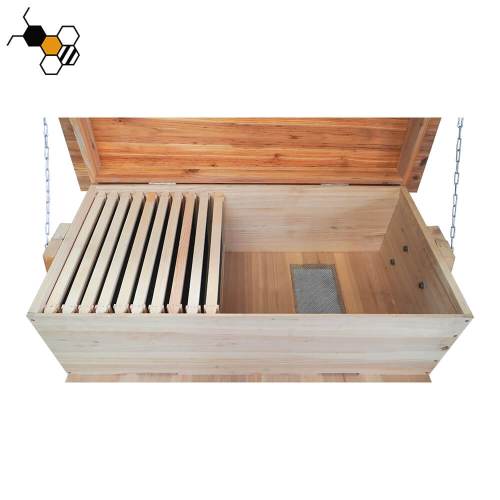Horizontal Beehive VS Langstroth Beehive
Beekeeping has become increasingly popular, and selecting the right beehive is crucial for successful hive management. Among the various hive designs available, the horizontal beehive and Langstroth beehive are widely recognized. This article aims to provide a comprehensive comparison of these two types, highlighting their features, benefits, drawbacks, and considerations for beekeepers.

I. Horizontal Beehive:
The horizontal beehive, also known as a top-bar hive, is characterized by its horizontal design, where the frames are aligned parallel to the hive entrance. Let’s explore its unique features and advantages:
Construction and Design:
- The horizontal hive consists of rectangular or trapezoidal frames, usually without any foundation.
- It typically has a sloping roof to aid water drainage and prevent moisture buildup.
- The hive can be constructed with various materials, such as wood or plastic.
Hive Management:
- The horizontal alignment of frames allows for easy management and inspection of the entire hive.
- Beekeepers can observe individual frames without disturbing the entire colony.
- Hive manipulation, including swarm prevention, comb management, and honey harvesting, is generally less invasive.

Bee Behavior:
- Horizontal hives mimic the natural shape of a hollow log, which is more appealing to bees from a biological perspective.
- Bees tend to build comb in a more natural, vertical manner, which simplifies their activities and reduces the likelihood of cross-combing.
Cost and Accessibility:
- Horizontal hives can be a more cost-effective option, as they often require fewer materials and are simpler to construct.
- Their user-friendly design makes them accessible to both experienced and novice beekeepers.
II. Langstroth Beehive:
The Langstroth beehive, invented by Reverend Lorenzo Langstroth in the mid-19th century, revolutionized modern beekeeping. Here are its key features and benefits:
Construction and Design:
- The Langstroth hive consists of vertical boxes (supers) stacked on top of each other, separated by frames with a foundation.
- The frames are removable and standardized, making them compatible with various Langstroth hive components available in the market.
- A telescoping roof provides protection from the elements.

Beehive Management:
- The vertical design makes hive management efficient, allowing easy access to frames from the top or bottom.
- Beekeepers can inspect, manipulate, and harvest honeycombs from individual frames without unnecessary disturbance to the colony.
Hive Population Potential:
- Langstroth hives can accommodate larger populations due to their expandable nature.
- Multiple supers can be added as the colony grows, providing ample space for bees to store honey and raise brood.

Honey Production:
- The use of standardized frames with foundations encourages bees to build straight and uniform comb, resulting in easily extractable honey.
- Extracting honey from frames is typically accomplished using honey extractors, which efficiently separate honey without destroying the comb.
III. Considerations for Beekeepers:
Beekeeper Experience and Preferences:
- Novice beekeepers may find horizontal hives less intimidating due to their simpler design and management techniques.
- Experienced beekeepers often appreciate the efficiency and honey production potential offered by Langstroth hives.
Regional and Climatic Factors:
- Consider the local climate, as horizontal hives may be better suited to areas with hot or tropical climates, while Langstroth hives can adapt to various conditions.
Hive Mobility and Transportation:
- Langstroth hives are more easily transportable, as they can be stacked and secured for relocation or migratory beekeeping practices.

Conclusion:
Choosing the right beehive is a crucial decision in beekeeping. The horizontal beehive offers simplicity, natural comb-building, and ease of use, while the Langstroth beehive provides efficiency, scalability, and standardized management. Carefully consider your experience, climate conditions, and hive management objectives to select the beehive that best suits your beekeeping goals. Ultimately, both hive types have their unique advantages, enabling beekeepers to nurture healthy and productive honeybee colonies.
